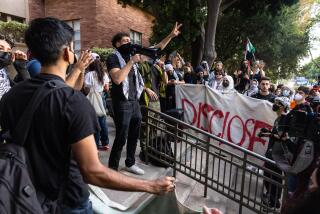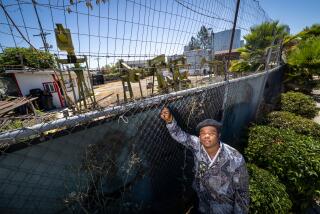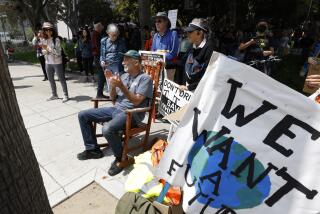Occupy anniversary: Marches, arrests but, ultimately, less energy
NEW YORK -- Protesters marked the first anniversary of Occupy Wall Street on Monday with a day of marches that choked Manhattan’s financial district and led to scores of arrests, but that ultimately suggested a movement missing the numbers and energy that propelled it to national prominence last year.
For a while in the afternoon, the scene at Zuccotti Park, the plaza that became the first encampment for Occupy protesters, resembled what it had been before police dismantled the tents on Nov. 15, 2011, leaving Occupy without a permanent home.
As a drummers’ circle pounded away in one corner, marchers waving signs milled throughout the park and stood on the sidewalks surrounding it, staring down police in riot gear and bellowing anti-greed messages.
Occasionally, groups peeled out of the park and began marching along Broadway, scattering tourists and passers-by. But from early morning until the evening, the group’s attempts to derail the financial district were stopped by police who erected metal barricades and swiftly arrested protesters who linked arms and sat down in an attempt to block sidewalks.
Mark Bray, a spokesman with Occupy Wall Street, said that despite the arrests and blockades, the protests had achieved their goal. “They had the intended effect of making sure the people trying to go to work knew we were there,” said Bray.
He seemed unconcerned about the possibility of losing public support by making it difficult for people to get to work. “The way to get public discourse on issues is to get out on the street and disrupt the flow of daily business,” he said.
More than 100 people were arrested, most on disorderly conduct charges. As marchers’ attempts to approach the Stock Exchange were repeatedly foiled, they broke into smaller groups and headed in different directions, playing a cat-and-mouse game with officers that lasted for hours.
Arrests, but no true disruption
As always, the marchers were a mix of old and young, well-dressed and slovenly, and they waved signs reflecting various issues: “Less Fascism, please,” ”Health care is a human right,” “Obama’s a nice guy but a bad businessman,” “End capitalism.” Others lamented high rates of student debt and foreclosures.
There was a healthy dose of humor amid the angry chants for an end to financial inequality. Some protesters brought enough musical instruments for a small brass band and played “Happy Birthday” as handfuls of confetti rained down. Many wore party hats in honor of the movement’s anniversary.
A woman wearing lingerie held a sign that read: “Naughty bankers need a spanking and jail time.” A man wore a giant cartoonish head of board game character Mr. Monopoly.
Some onlookers criticized the movement for what they called its lack of focus and failure to use an election year to back particular candidates or adopt specific issues.
“I think they’re idiots. They have no agenda,” Robert Nicholson, who works on Wall Street, said as he stood outside his office building watching a handful of protesters march by. “They have yet to come out with a policy statement, and now, who are they disrupting? People who are working, people who are trying to pay a mortgage or put their kids through school.”
But the movement’s loyalists say policy statements never were part of the plan. “In my mind, it didn’t set out to accomplish X, Y and Z,” said Mikell Kober of Brooklyn, who had joined a break-off group of protesters outside a Bank of America branch on Broadway. Rather, she said, it “was about creating a public space where people could gather and have a conversation about the things that need to change.”
At Pine Street, near the Stock Exchange, protesters erupted in chants of “We’re still here!” and “We are the 99%!” as they jostled with police and commuters trying to squeeze through barricades to reach work.
Tina Campbell, who had come from Philadelphia for the anniversary, had not expected such a turnout. “I was pleasantly surprised, because you just never know. Americans are a little complacent,” said Campbell, who described herself as a longtime activist. “I feel like there’s got to be bodies in the streets for Americans to wake up.”
The future of Occupy Wall Street
The question now is whether Occupy Wall Street will be able to maintain momentum to mark its second anniversary with similar numbers.
Kober said losing its place in Zuccotti Park had hurt the movement by denying it a public conversation spot. She also said Occupy’s refusal to go mainstream by appointing “leaders” and adopting specific issues had led to some fracturing of the group and the muddying of its general anti-greed message.
“It does become a sounding board for a lot of anger, which can be misdirected,” she said.
Bray said the movement had the disadvantage of having been catapulted to fame when it was still in its fledgling state, before it had time to organize its political leanings and offer the sort of message that keeps a movement relevant.
“Now, I think the goal is to go back and do that nitty-gritty political work that usually precedes media attention,” he said.
ALSO:
Teens who ‘sext’ more likely to have sex, study suggests
Nevada recluse dies with $200 in bank, $7 million in gold at home
Penn State’s Jerry Sandusky to be sentenced October 9 for child abuse
More to Read
Sign up for Essential California
The most important California stories and recommendations in your inbox every morning.
You may occasionally receive promotional content from the Los Angeles Times.











